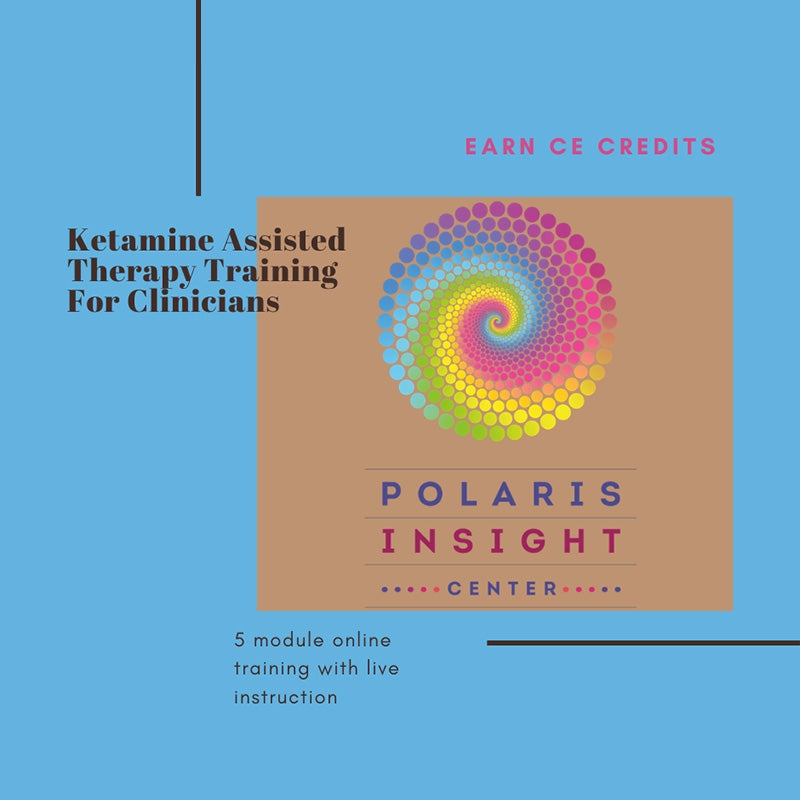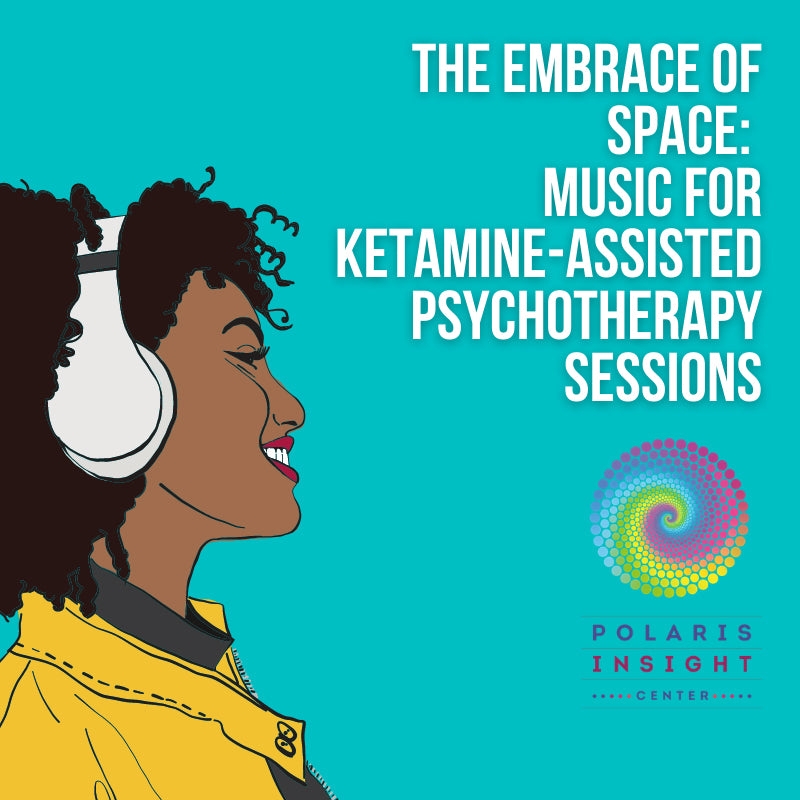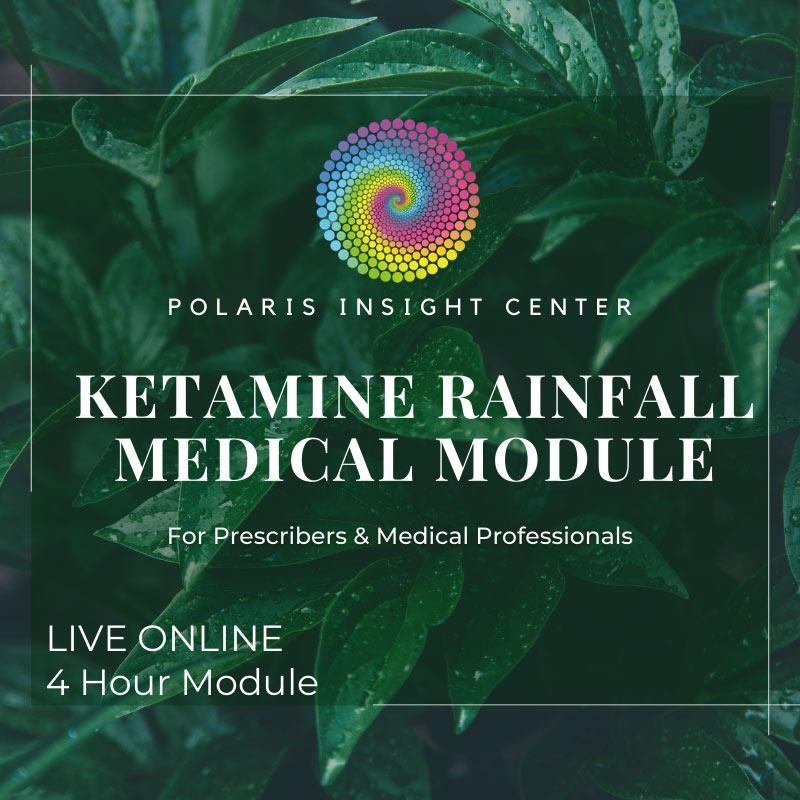San Francisco-based ketamine-assisted psychotherapy clinic, Polaris Insight Center, is one of a number of relatively new clinics working with an integrative model of ketamine treatment and recovery. The focus of this article is to describe how KAP is conducted in our own clinical practice, addressing important elements of psychedelic psychotherapy, including preparation, set and setting, and integration, and highlighting some of the fundamental guiding principles of the work.
Our perspective is informed by years of clinical experience and observations drawn from thousands of KAP sessions. We completed our initial training in KAP with Phil Wolfson and Julane Andries through the Ketamine Training Center, and with Raquel Bennet through the Kriya Institute. In addition, we received training through the MAPS MDMA-Assisted Therapy Training Program, including training in clinical supervision of new therapists entering the field.
Although prior to our work in psychedelic-assisted psychotherapy we came from diverse clinical and philosophical backgrounds, we are all strong believers in the healing power of human relationship and the therapeutic potential of expanded or non-ordinary states of consciousness (NOSC). We view KAP as holding enormous reparative potential in its unique synthesis of therapeutic elements, while also honoring the biological benefits of ketamine.
Since the early 2000s in the United States, an increasing number of ketamine IV infusion clinics have been established to provide off-label treatment for depression (particularly, treatment-resistant depression or TRD). The use of low-dose (i.e, sub-psychedelic) ketamine infusion sessions (<0.5 mg/kg) to elicit antidepressant response without the dissociative/psychedelic “side-effects” (i.e., also known as the “emergence phenomenon”) have almost exclusively been used in the ketamine research 7.
Follow your Curiosity
Sign up to receive our free psychedelic courses, 45 page eBook, and special offers delivered to your inbox.Although ketamine administered at these lower doses can provide significant relief from depression, these treatments do not necessarily – or even typically – involve specialized psychological care, such as psychological assessment, psychoeducation on working with NOSC, or discussions of aspects of set and setting, preparation, and integration. These psychotherapeutic elements have become components of the standard of care throughout psychedelic-assisted psychotherapy research and practice over the past two decades.
Ketamine infusion treatment relies solely on the biological effects of ketamine. Ketamine-assisted psychotherapy relies on the therapeutic relationship (or therapy “container”) and the transformative experience facilitated by entering into the NOSC as primary vehicles of symptom relief and personality change. The route of administration of KAP is usually sublingual, using rapid dissolvable tablets or lozenges/troches, or intramuscular (injected into the deltoid muscle).
Unfortunately, research comparing results of KAP and IV ketamine treatment has not been conducted, although some preliminary data has been generated4 on the effects of KAP across three private practice settings and hundreds of patients. Nevertheless, we anticipate that KAP treatment outcomes might be often superior to IV ketamine treatment outcomes due to the potential to address and resolve, through the psychotherapeutic process, the patient’s deeper underlying psychological conflicts and issues.
KAP allows for therapeutic work beyond symptom relief, addressing underlying attachment, addiction, anxiety, spiritual, somatic, existential, trauma/ptsd, and relationship issues and challenges in an ongoing dialogue and integration process with a trained psychotherapist. It is important to note that KAP requires the therapist to be trained specifically in KAP, which is different from having a trained therapist (e.g., in CBT, DBT, EMDR, or Hakomi) sitting with a client who receives ketamine.
Practiced at Polaris, ketamine-assisted psychotherapy incorporates the benefits of both the low to moderate dose psycholytic (empathogenic) and moderate to high-dose psychedelic (ego-dissolving) sessions while recognizing the powerful neuro-biochemical effects of the medicine12,16. Learn more about ketamine in the Psychedelic Support Network’s substance guide.

In addition, clients are prepared to welcome all experiences – both positive and challenging as part of the healing process. Positive experiences, for example the feeling of awe, wonder, interconnectivity, and/ or deep peace that can happen in a psychedelic experience, are important aspects of the transformational process as they can “reboot the system” while reminding the client of their capacities for healing, joy and positive human connection. Challenging experiences – personal or transpersonal – are also paradoxically central to the healing process, helping clients with a sense of mastery, agency, and resilience in the face of overwhelming and confusing experiences.
Paradigms of Working with Ketamine
Bennett describes three paradigms of working with ketamine: biological, psychological, and shamanic/transpersonal1.
Although the understanding is still evolving, the biological model emphasizes the biochemical and neurobiological effects of the medicine and understands therapeutic change in terms of central nervous system changes such as the increase glutamate and BDNF (brain-derived neurotrophic factor) levels, reduction of functional connectivity in the default mode network, promotion of synaptogenesis, and formation of new neural pathways15,18.
The psychological paradigm, on the other hand, places emphasis on the psychotherapeutic process and reparative relationship with therapist, and understands treatment change as the result of accessing and processing long-standing struggles (intrapsychic, relational, and existential conflicts), and resolving longstanding issues of identity, attachment, values, life meaning, purpose and direction. Therapeutic effects in the psychological paradigm include gaining distance from one’s usual personality (i.e., strengthening observing ego functions), gaining new perspectives on conditioned beliefs, patterns of thinking, feeling, and behaving, and learning how to relate more vulnerably and authentically with the therapist and others.
Accessing unresolved traumatic experiences and beliefs is another major aspect of the psychological model. The effective processing of traumatic experience may also allow for important reconnection with disavowed and dissociated aspects of the self, along with attachment repair, all leading to enhanced resilience. The cultivation of cognitive-emotional flexibility is a hallmark of the psychological benefits of KAP over time. As emotional obstacles and psychological defenses are diminished in both psycholytic and psychedelic KAP sessions, in a field of safety and support, clients may discover a spaciousness of mind previously unavailable to them, and a connection to a benevolent, non-judgmental form of spirituality.
Finally, the spiritual/shamanic/transpersonal paradigm is useful for understanding novel and sometimes otherworldly, spiritual, phenomenological, or mystical phenomena that arise in higher-dose psychedelic sessions. In this model, therapeutic change is viewed as a result of a greater capacity to access deeper levels of the unconscious (biographical, archetypal and transgenerational) mind and connect with transpersonal realms of experience.
From a transpersonal perspective, therapeutic change may involve access to a more expansive sense of self, unity consciousness and the sense of interconnectivity. This expanded perspective shift can diminish feelings of alienation and shame, cultivate self-compassion, through transcending the limits of one’s body, ego, and conditioned mind. This can sometimes lead to relief of existential distress as well as to gaining a deeper understanding of one’s life purpose. Clients can not only experience a decrease in symptoms, but also gain self-awareness, self-transcendence, and a greater sense of meaning7. As part of this process, clients may tap into a part of the self that has never been damaged or contaminated by destructive life experiences and may also come to understand their own organic inner healing intelligence – often a sharp contrast to the devalued or disgraced sense of self many struggle with for years as a bi-product and co-factor of chronic mental illnesses.
It should be noted that we believe that good KAP practice is essentially a hybridization of the three treatment paradigms, which of course are not mutually exclusive. Our approach to KAP is informed by perspectives and ways of action from each of the three paradigms at various times during the course of a given treatment. How the clinician explicitly understands and describes progress in treatment, and the specific language used for clinical purposes, should be determined by the semantic lens used by the client to understand their experiences.
Ethical Guidelines
Bennett2 published ethical guidelines that highlighted the importance of mental health providers being present during sessions when working with “therapeutic ketamine”. Still in 2022, most ketamine clinics in the United States have little or no psychotherapy included in their treatment protocols. Bennet describes the incidence of adverse events during or after ketamine sessions to be linked to factors such as misrepresentation by providers of ketamine as a “cure” or “magic bullet” for multiple conditions, an insufficient screening process, lack of psychotherapeutic support during and after sessions, and insufficient training of providers.

Many in the field have come to believe that there is a need to shift from a purely biomedical model to an interdisciplinary and collaborative model. This collaborative model informs our approach to KAP. The prescriber is responsible for the medical intake/assessment, dosing, and medical monitoring. Prescribers work in a close collaboration with the therapist to determine if the client is suitable for ketamine-assisted psychotherapy. The dosing strategies for the initial and subsequent sessions are continually discussed and reviewed by the prescriber, therapist, and client. In addition to the prescriber and the therapist, the client’s primary therapist and/or psychiatrist, often outside of the clinic, may also be part of the care team, and such collaboration is encouraged.
The KAP therapist is present throughout the whole treatment process, in all preparation and dosing sessions, and also is an integral part of the ongoing integration process. Aside from intensive training in KAP, it is important that KAP therapists cultivate and embody qualities of compassion, mindfulness, and honesty, as well as commitment to seeking continuing education and consultation with more experienced KAP clinicians/supervisors. Many potential ethical pitfalls endanger the growing landscape of ketamine treatment. Our hope is that standard ethical guidelines of care and professionalism for therapeutic ketamine providers will be widely accepted and that psychotherapeutic care will be routinely provided throughout ketamine treatment.
Set and Setting for KAP
Ketamine holds the potential to elicit powerful and sometimes life-changing experiences16. Therefore, we believe it is important to hold that in mind in every step of the therapeutic process. In past psychedelic research with psilocybin6 participants rated the experience as one of the five most important experiences in their life and the third most important experience in their life. Similar comments have been made by clients over the years in a variety of psychedelic research and practice settings.
Ketamine-assisted therapy is provided in a comfortable, pleasing environment, conducive to relaxation and letting go of cares and stress. We pay great attention to the preparation phase and the optimization of set and setting8. Attention is paid to preparing the setting: being sure the clinic space is aesthetically decorated and the room equipped with a bed, bedding, eye mask, and a good sound system. We want to create an environment where clients feel safe, welcomed, and comfortable to engage in the treatment. We invite clients to bring any important items or pictures into the space and to create their own altar to personalize the space, and we use invocations and specially curated ambient music playlists.

The patient’s set must also be considered, explored and supported. Set refers to the patient’s current state of mind, mood, attitude, interpersonal or professional concerns, beliefs about psychedelic medicines, and expectations about the specific psychedelic session.
We encourage clients’ self-inquiry into the reasons for seeking KAP and journaling in the days leading up to the session to clarify their intention. We ask clients to verbalize an intention for the session, but at the same time to hold the intention lightly and even try to let go of any attachments to a specific outcome or “answer” to the intention. We encourage clients to invite “Beginner’s Mind” and not-knowing, openness, curiosity, and trust. Our philosophical approach combines a respect for both discipline and playfulness. Throughout the treatment process we attempt to impart to our patients the spirit of “welcoming everything,” approaching joyful and challenging experiences with equal measure, and understanding the value of awe, play, and wonder in the healing process.
The therapist’s set and cultural set are also important considerations in understanding the patient’s set. The set of the therapist refers to their frame of mind, mood, outside concerns, and hopes for the session and the treatment as a whole, and their influence on the patient and the session. There are, also, cultural variables of set, or what has been referred to as the “collective set-and-setting,”10 which comprises the perspectives and value systems of the family, society, and culture in which the individual is embedded. These further influence the patient’s set and which must be considered, explored and discussed prior to the psychedelic experience. All of these aspects are explored and tended to in the intake and preparation process.
Ketamine-Assisted Psychotherapy Protocol
KAP treatment protocol starts with medical and psychological intake and assessment. Even though ketamine has an excellent pharmacological safety profile16, there are physiological and psychiatric contraindications, such as history of heart, liver, or kidney disease, uncontrolled hypertension, history of or current symptoms of psychosis, and current symptoms of mania, and not everyone is a good candidate.

The consent process is an important part of this initial phase of treatment, and since ketamine is a schedule 3 medication used off-label, the physician needs to discuss with the client the rationale for use, inform them of potential risks, and present treatment alternatives. Then a treatment plan is developed, which typically involves a more intensive, initial phase of treatment, with more frequent sessions in a shorter period of time, followed by a less intensive maintenance phase.
This initial phase of treatment involves a series of KAP sessions book-ended by one or more preparation sessions prior to the series and one or more integration sessions interspersed within and/or following the series. Substantial time and energy are spent in the preparation and integration phases of the treatment, and they are considered as important – if not more important – than the experiential sessions. As the field of ketamine- and psychedelic-assisted psychotherapy have matured over the years, the value of ongoing integration to mine and extend the benefits, insights, and inspirations for behavior change attained in the medicine sessions has come to be highly valued and seen as essential to durable and lasting change.
A typical KAP treatment for depression at Polaris Insight Center, for example, consists of 4 – 6 sessions (each 3 hours) over the course of 2 – 4 weeks, followed by more spaced-out booster sessions during the maintenance phase of the treatment. The typical length of treatments at our center is 3 – 6 months. The treatment protocols are individualized based on the client’s diagnosis, symptoms, and responsiveness to the treatment.
Based on our training in the MAPS protocol for MDMA-assisted therapy for the treatment of PTSD and the Ketamine Training Center, we have decided to adopt the therapeutic approach of inner-directed psychotherapy. The main guiding principle in this approach is following and activating of the patient’s the inner healing intelligence, which is conceptualized as a “universal capacity to self-heal”. In the same way that the physical body is able to heal, this approach states that the psyche, under specific conditions, moves toward resolution14.
For example, if a person has a cut, they might have to disinfect it, or even get stitches, but it is the body that heals from within. Similarly, when we provide the optimal conditions, the psyche is able to move towards processing, integrating, and re-regulating. When the therapist follows the client, using an inner-directed psychotherapy approach, rather than coming in with a specific agenda for what should happen, they can support the therapeutic process that needs to happen5.
We also believe in cross-pollination between approaches, and when therapists are trained in multiple modalities (e.g. Hakomi, Somatic Experiencing, Internal Family Systems, Archetypal and Relational Psychotherapy approaches) they can incorporate those with the inner-directed approach.
The therapist’s role is also one of a sitter supporting the client’s emergent process, encouraging the client to welcome whatever is coming up and to be curious. This support involves empathic listening, and also attachment work, trauma processing, and working with other conflicts that might emerge during and after the experiential session. The client is encouraged during the experiential session to describe what they are noticing, check in with their emotions and sensations, and share any insights. The therapist engages with the clients around the material they share and facilitates continued containment and processing as needed. The therapist also serves a role as a scribe and takes detailed notes of what the client said and uses them in the discussion and later throughout the integration.
The end of the experiential session is the beginning of the integration process when the client is beginning to put words to their experience. They are encouraged to take care of their physical needs and continue to connect with the material through journaling, re-listening to the playlist used in the session, being in nature, moving, and dancing. They are asked to avoid social media, TV, and engaging in difficult conversations – is recommended days after the session.
In addition to providing check-ins with the client over email as well as an additional integration session, we also require clients to work with an outside therapist. Some clients will have another ketamine session within a few days, and the beginning of this session serves as a review of the previous session and preparation for the following session.
The integration process often extends the time of the initial KAP protocol and might continue for weeks or months following the initial treatment protocol. Integration involves working with the patient to make meaning from the experiential session, continue to process what emerged, and to apply new perspectives and insights in their daily lives.
The therapist makes use of transference and countertransference in the therapeutic relationship. This phase of the treatment can be challenging as (sometimes) a patient’s symptoms can get worse before they get better due to deepening engagement with potentially distressing material. And, paradoxically, even positive changes have the potential to be stressful. This sometimes rapid improvement (“therapeutic bends”11) may stress the patient’s family system and require further emotional, personal, interpersonal and/or transpersonal processing. As the patient’s identity rapidly shifts from the sick role to recovery, they may also face a wide array of unforeseen practical and relationship challenges. Integration challenges point to the imperative of spending time refining the preparation protocol, striving to continually optimize set and setting, and providing psychotherapeutic support throughout the process. Comprehensive assessment, ongoing and iterative informed consent practices, and attention to the patient’s intentions and goals, in the preparation phase, can go a long way to paving a smooth road for integration.
Challenges and New Opportunities of KAP
In general, lack of diversity and access are two issues facing the field of psychedelic-assisted therapy (including KAP). Due to the lack of cultural diversity among therapists providing KAP, this treatment may be less inviting to culturally diverse clients, and the current protocols have mostly not been modified based on cultural needs. The mental health community needs to make efforts and strive to find ways to change this situation. Providers must recognize that clients of various backgrounds will not resonate with one, uniform setting or approach. One size does not fit all. Providers need to also consider how certain elements of the setting, e.g. office decorations and different types and styles of music on the playlists, may impact the client. It is crucial to explore diversity, cultural, and personal preferences in treatment and begin conversations about these topics as well as power dynamics as early on in the intake and preparatory process as possible.
One of the biggest challenges is accessibility of this treatment. We have experimented with shorter 90- and 120-minute sessions, but we have come to an understanding that 150 to 210-minute sessions are ideal, with most clients needing 180-minute sessions to get the fullest benefit. The treatment is labor intensive and requires the presence of the therapist and often MD or RN on site. Currently insurance companies in the United States do not cover KAP and so the treatment is rather costly.
Before the COVID-19 pandemic, we could not have imagined being able to provide KAP online. This world-wide crisis has created a necessity, and in the United States an opportunity, to explore doing KAP virtually. Currently, several companies in the US are offering virtual KAP treatments. It has not only been possible, but, for some clients, it has become the more favorable option, due to the benefits of being in the comfort of their own home and not having to commute to appointments. It has also made the treatment more geographically and financially accessible. For virtual KAP, clients use ketamine lozenges that they self-administer, and they are monitored through an online HIPAA-compliant video platform. We anticipate that this new way of working will survive beyond COVID-19, and thus, out of tragedy, a promising new form of this treatment will evolve.
Becoming a ketamine-assisted psychotherapist is a path of learning, but also unlearning. The ideal training structure includes didactical training, personal experience, group experience, shadowing, live supervision, mentorship, and ongoing consultations. The field of KAP is quickly evolving and legal and ethical standards are being developed. As a result, the development of training programs that support the growing number of clinicians in the field is imperative. Beyond their initial training, clinicians will need to participate in ongoing group and individual consultation/supervision processes in order to continue to hone their skills, understand the unique transference-countertransference challenges in KAP, connect with a community of like-minded practitioners, and stay abreast of the latest research data and practice innovations being developed in the field.
We see that the journey of becoming an effective KAP therapist takes individual, group, and community support and a breadth of experience over time. Together with the Rainfall Medicine Clinic we are offering Polaris/Rainfall KAP Practitioner Training Certificate Program, a pathway that will reflect the commitment of time, energy, and practice to cultivate confidence and demonstrate competence in providing ketamine-assisted psychotherapy.
References
- Bennett, R. (2019). Paradigms of ketamine treatment. MAPS Bulletin Spring 2019, 29(1), 48-49.
- Bennett, R. (2020, December). Ethical guidelines for ketamine clinicians. The Journal of Psychedelic Psychiatry, 2(4).
- Corssen, G. & Domino, E. (1966). Dissociative Anesthesia. Anesthesia & Analgesia, 45(1), 29 – 40.
- Dore, J., Turnipseed, B., Dwyer, S., Turnipseed, A., Andries, J., Ascani, G., Monnette, C., Huidekoper, A., Strauss, N., & Wolfson, P. (2019). Ketamine assisted psychotherapy (KAP): Patient demographics, clinical data and outcomes in three large practices administering ketamine with psychotherapy. Journal of psychoactive drugs, 51(2), 189–198. https://doi.org/10.1080/02791072.2019.1587556
- Gorman, I., Nielson, E. M., Molinar, A., Cassidy, K., & Sabbagh, J. (2021). Psychedelic Harm Reduction and Integration: A Transtheoretical Model for Clinical Practice. Frontiers in Psychology, 12, 645246. https://doi.org/10.3389/fpsyg.2021.645246
- Griffiths, R. R., Johnson, M. W., Carducci, M. A., Umbricht, A., Richards, W. A., Richards, B. D., Cosimano, M. P., & Klinedinst, M. A. (2016). Psilocybin produces substantial and sustained decreases in depression and anxiety in patients with life-threatening cancer: A randomized double-blind trial. Journal of psychopharmacology (Oxford, England), 30(12), 1181–1197. https://doi.org/10.1177/0269881116675513
- Grob, C. & Grigsby, J. (2021). Handbook of Medical Hallucinogens. New York: The Guilford Press.
- Gold, V. & Sienknecht, E. (2018). Ambassadors to hidden territories: Set and setting in psychedelic assisted psychotherapy. Chacruna Institute Online. https://chacruna.net/ambassadors-to-hidden-territories-set-and-setting-in-psychedelic-assisted-psychotherapy/
- Gold, V. & Sienknecht, E. (2020). Ketamine-assisted-psychotherapy online. Psychedelic Support Online. https://psychedelic.support/resources/ketamine-assisted-psychotherapy-online/
- Hartogsohn, I. (2013). The American trip: Set, setting, and psychedelics in 20th century psychology. MAPS Bulletin Spring 2013, 3(1), 6 – 9.
- Katzman, J. (2018). Rapid Depression Remission and the “Therapeutic Bends”. Healing Realms Online. https://www.healingrealmscenter.com/blog/rapid-depression-remission-and-the-therapeutic-bends
- Kolp, E., Friedman, H. L., Krupitsky, E., Jansen, K., Sylvester, M., Young, M. S., & Kolp, A. (2014). Ketamine psychedelic psychotherapy: Focus on its pharmacology, phenomenology, and clinical applications. International Journal of Transpersonal Studies.
- Li, M., Woelfer, M., Colic, L., Safron, A., Chang, C., Heinze, H. J., Speck, O., Mayberg, H. S., Biswal, B. B., Salvadore, G., Fejtova, A., & Walter, M. (2020). Default mode network connectivity change corresponds to ketamine’s delayed glutamatergic effects. European archives of psychiatry and clinical neuroscience, 270(2), 207–216. https://doi.org/10.1007/s00406-018-0942-y
- Mithoefer, M. et al. (2017). A manual for MDMA-assisted psychotherapy in the treatment of posttraumatic stress disorder; Version 8. http://www.maps.org/research/mdma/mdma-research-timeline/4887-a-manual-for-mdma-assisted-psychotherapy-in-the-treatment-of-ptsd. Accessed 2 April 2019
- Scheidegger M., Walter M., Lehmann M., Metzger C., Grimm S., & Boecker H, et al. (2012). Ketamine decreases resting state functional network connectivity in healthy subjects: Implications for antidepressant drug action. PLoS ONE 7(9), 1-9. https://doi.org/10.1371/journal.pone.0044799
- Wolfson, P. & Hartelius, G. (2016). The Ketamine Papers. MAPS.
- Zarate, C., Singh J., Carlson, P., et al. (2006). A randomized trial of an N-methyl-D-aspartate antagonist in treatment-resistant major depression. Arch Gen Psychiatry, 63(8), 856–864. doi:10.1001/archpsyc.63.8.856
- Zunszain, P., Horowitz, M., Cattaneo, A., Lupi M., & Pariante, C. (2013). Ketamine: synaptogenesis, immunomodulation and glycogen synthase kinase-3 as underlying mechanisms of its antidepressant properties. Mol Psychiatry 18, 1236–1241. https://doi.org/10.1038/mp.2013.87









